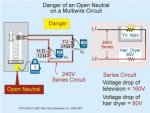I am closing this thread, in accordance with the
Forum rules. This Forum is intended to assist professional electricians, inspectors, engineers, and other members of the electrical industry in the performance of their
job-related tasks. However, if you are not an electrician or an electrical contractor, then we are not permitted to help you perform your own electrical installation work.
If I have misjudged the situation, if for example this project is related to your work, then send me a Private Message. If you can show me that I am wrong, and that you are a licensed electrician (or at least a licensed apprentice), then I will reopen your post, and offer an apology for the delay and inconvenience.
A reminder to all members, if you see a questionable post, feel free to report it by clicking the
button at the bottom left corner of the post.
-------
That said, I will also point out to you that the various loads connected to L1 and L2 form a voltage divider across the 240V potential, with the open neutral bus being the connection between the two sides. The result is that, depending on the resistance of the things connected to both legs the voltage across each side can range from close to zero volts all the way up to close to 240V. You are fortunate the results were not worse.
PS: What Augie said....



